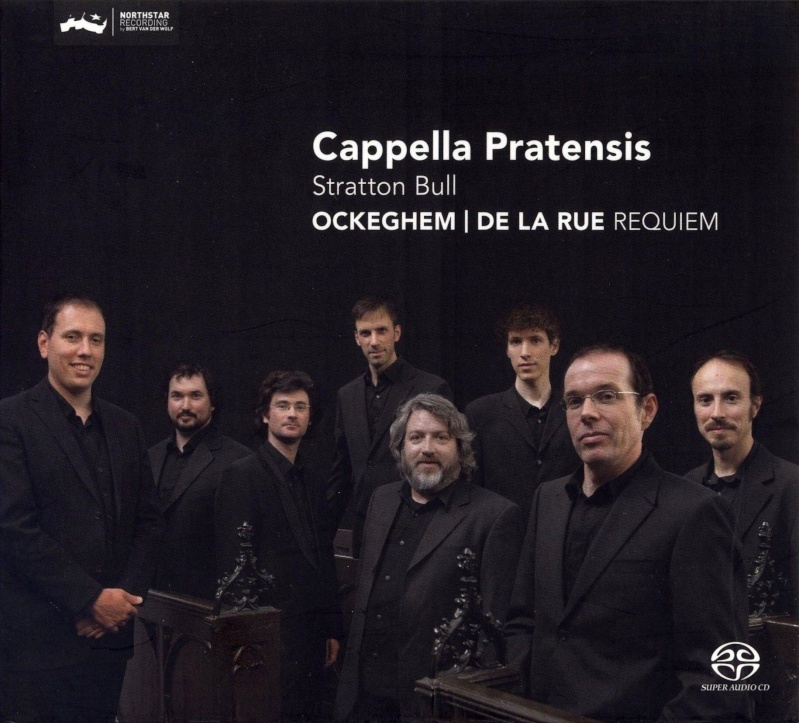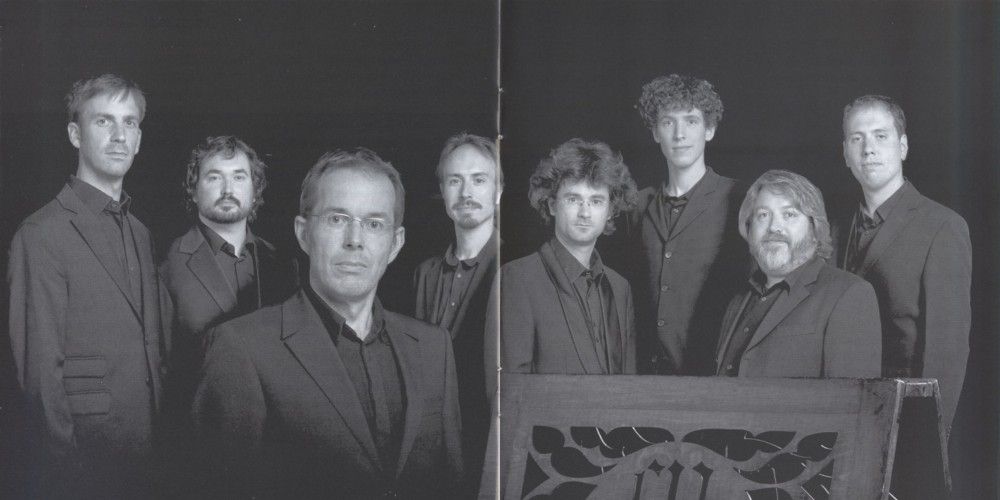
cappellapratensis.nl
challengerecords.com
medieval.org
Challenge Classics 72541
2011
Johannes OCKEGHEM
01 - Introitus. Requiem aeternam [4:25]
02 - Kyrie [4:19]
03 - Graduale. Si ambulem [4:28]
04 - Tractus. Sicut cervus [7:25]
05 - Offertorium. Domine Jesu Christe [8:10]
Piere de la RUE
06 - Introitus. Requiem aeternam [4:18]
07 - Kyrie [2:47]
08 - Tractus. Sicut cervus [3:26]
09 - Offertorium. Domine Jesu Christe [6:45]
10 - Sanctus [5:04]
11 - Agnus Dei [3:24]
12 - Communio. Lux aeterna [2:42]
Cappella Pratensis
Stratton Bull
Stratton Bull, superius
Andrew Hallock, superius
Christopher Kale, altus
Lior Leibovici, altus
Olivier Berten, tenor
Peter de Laurentiis, tenor
Lionel Meunier, bassus
Pieter Stas, bassus
Executive producer: Anne de Jong
Recording location: Church of Vieusart (Belgium)
Recording dates: 9-12 June, 2011
Recording producer: Bert van der Wolf
Recorded by: NorthStar Recording Services
Photography: Vincent Nabbe

The Requiems by Ockeghem and La Rue
This recording presents the two earliest surviving polyphonic Requiems,
by Johannes (Jean de) Ockeghem and Pierre de La Rue, both among the few
major Netherlandish composers of the time not to have spent significant
portions of their careers in Italy. Little is known of the early career
of La Rue (c. 1452-1518), but from 1492 he served successive rulers in
the Habsburg-Burgundian chapel alongside equally distinguished
musicians, first under Maximilian, then Philip the Fair (with whom he
travelled twice to Spain), and finally, the cultivated and tragic
figure of Marguerite of Austria, regent of the Netherlands, for whom
many of his most beautiful sad songs were written.
Ockeghem died in 1497; his birth date has been estimated at several
years on either side of 1420. He is first documented as an adult singer
in Antwerp in 1443, then in the service of Charles, Duke of Bourbon,
before entering the French royal chapel in the 1450s. He enjoyed the
patronage of Charles VII who nominated his first chaplain to the
lucrative position of treasurer of St Martin in Tours, a favour
continued under Louis XI. He was held in the highest repute in his
lifetime, alongside Du Fay and Busnoys (with both of whom he had direct
contacts), Binchois (on whose death in 1460 he wrote a
Déploration), Josquin, and other composers less well known to
us. Johannes Tinctoris honoured him in two treatises of the mid 1470s;
he was much cited by contemporaries and throughout the next century,
even after direct knowledge of his music was no longer current. Kindly,
benign, pious, and of irreproachable virtue — this is the image
that has come down to us. His death was lamented in at least two
musical works: Busnoys's In hydraulis and Josquin's Nymphes
des bois, adapted from a poem by Jean Molinet enjoining major
contemporary composers to lament their 'good father', and in a long
poetic Déploration by Guillaume Crétin.
The earliest liturgical chants to receive polyphonic elaboration, in
the twelfth century, had been for joyful occasions of the church year;
the latest, in the fifteenth, were for seasons of mourning, both the
Passion and death of Christ, and human commemoration, for which the
Church has abidingly discouraged musical adornment. The earliest
polyphonic Requiems are, accordingly, restrained and austere,
understated in comparison with the normal musical styles of their
composers, in fewer parts, and relatively homophonic. Whereas most Mass
Ordinaries composed around 1500 set all five movements on a unifying
musical theme or model, early Requiems base each movement on its
corresponding chant; while there may be an overall sombre mood, the
sections are not thematically unified. In Ockeghem's case, the chants
are usually in the superius and only lightly embellished, which already
makes for a more archaic effect; in La Rue's Requiem the chant is often
in the tenor but permeates the other parts imitatively. Other early
settings were composed by Févin (or Divitis), Brumel, Richafort,
Prioris, and anonymous composers including some Spaniards. There is no
standard practice as to which movements are set. Ockeghem sets the
Introit, Kyrie, Gradual, Tract and Offertory but not the Sanctus, Agnus
and Communion; La Rue sets the Introit, Kyrie, Tract, Offertory,
Sanctus, Agnus and Communion but not the Gradual. The Dies irae,
which dominates most later Requiems, was one of the few Sequences to
survive the liturgical reforms of the Council of Trent but, of these
composers, only Brumel sets it. It was usually omitted in early
northern European Requiems, whose texts differ from Roman and southern
European traditions, with some variants in the Offertory, and use of
the Gradual Si ambulem and the Tract Sicut cervus,
instead of Requiem aeternam and Absolve domine.
Each of the present settings is preserved in a manuscript from the
famous Alamire workshop (respectively Vatican Library, MS Chigi C VIII
234, and Jena, Universitätsbibliothek, Chorbuch 12). The primacy
of Ockeghem's gives it special significance for us, but it did not have
a circulation commensurate with his reputation; its transmission was
extremely fragile, in a single source and with many anomalies. By
contrast, La Rue's Requiem was much more widely copied, in six
manuscripts including some from the Bavarian court.
But there was one earlier Requiem which has not survived, by Guillaume
Du Fay (d. 1474), whose will prescribed in detail the arrangements for
his deathbed and funeral. His polyphonic Requiem was to accompany his
own biannual post mortem commemorations, and was requested by others in
the ensuing decades. Its afterlife was clearly much more vigorous than
Ockeghem's Requiem. In 1501, the Order of the Golden Fleece replaced
its weekly monophonic Requiem with Du Fay's setting, described by an
ear-witness as being for three voices, sad, solemn and very sweet (una
Messa a tre voci, flebile, mesta e suave molto). This implies a texture
much sparser than that of his lush four-part late masses, and indeed
could well apply to portions of Ockeghem's setting, notably the Introit
and Kyrie, to the extent that a few scholars have speculated whether
'Ockeghem's' Requiem could in fact be the 'lost' setting by Du Fay. But
this is belied by the richer four-part sections, especially the
elaborate rhythms of the Offertory, depicting infernal torments.
Indeed, the many stylistic contrasts and anomalies within the Ockeghem
Requiem are puzzling, notwithstanding brave attempts to argue their
coherence. The ninefold Kyrie, in particular, with its alternating
sections in two and three parts, has no precedent in Ockeghem's masses
but, apart from the final four-part section, uses a compositional
technique favoured by Du Fay and other composers of the previous
generation, and shows signs of adaptation from an earlier work. I have
tentatively suggested that Ockeghem may have incorporated some portions
of Du Fay's setting, adding and substituting sections of his own,
including all the four-part sections, and the entire Offertory, which
is strikingly different, and much closer to what we know of Ockeghem's
style elsewhere. His visits to Du Fay in Cambrai in 1462 and 1464
provide opportunities for the mutual influence that has been detected
in their compositions. Ockeghem also visited Cambrai in 1483, just two
weeks before one of the commemorations for which Du Fay had stipulated
his Requiem. He could have been present, at or even sung in it; the
restrained style implied by the description could at the very least
have inspired his own setting.
Although Ockeghem's Requiem uses no more than four notated parts at any
one time, only a tiny percentage, less than a fifth of the music, is
actually in four parts (the final sections of the Kyrie, Gradual and
Tract, and two sections of the Offertory). There are rather few
sections with reduced scoring in his other masses, making the
predominance of two and three-part writing in the Requiem all the more
striking. And yet, at least six voices (here, eight) are needed to cope
with the various combinations. Notated pitch was not tied to a standard
frequency, and low notation may in some cases have been symbolic. Other
masses show discrepancies of register; the movements of La Rue's much
more homogeneous setting are also notated at different levels. In that
case (unlike Ockeghem's) they can be brought closer together by
transpositions, the approach that has been taken for this recording.
The Chigi manuscript is the unique source for most of Ockeghem's
thirteen mass groupings; it may have been intended as a memorial
volume, an only partially successful attempt to assemble his complete
works. Some of those masses are patently incomplete, and we know he
wrote others that have not survived. The Requiem is an extreme case of
problematic transmission. If, like Mozart, Ockeghem had died in the
middle of composing his Requiem, Crétin (in the
Déploration referred to above) might not have described it as
'exquise et très-parfaicte'; even allowing for funerary
hyperbole, this is hardly an apt description of the incomplete and
inconsistent work that has come down to us, however beautiful we may
find it. But Crétin's testimony cannot be dismissed; he was a
musically knowledgeable professional, a cantor at the Sainte Chapelle,
a chaplain to François I, and held the position of treasurer at
Vincennes, parallel to that of Ockeghem at Tours. (Another reference
much later in the poem enjoins choirboys not to improvise florid but
only simple counterpoint on the Requiem chant; this probably does not
refer to Ockeghem's composition.) The Chigi scribe may have compiled
the work to the best of his ability from a miscellaneous assembly of
working drafts bearing Ockeghem's name, perhaps even including copies
of some sections of Du Fay's Requiem which Ockeghem was in process of
amplifying, more in the spirit of homage than of plagiarism. The result
shows some signs of being a work in progress. Was his Requiem
incompletely composed or incompletely transmitted? It is very uncertain
whether Crétin was describing it in the form in which we know it.
La Rue was a generation younger, but his Requiem is probably not much
later in date. (His motet-chanson Plorer, gemir, crier/Requiem,
based on the Introit for the Requiem Mass, may be a lament on the death
of the older composer.) Although all movements are likewise built on
their corresponding chants, they make a much more unified stylistic
impression than Ockeghem's. There is more imitation and chordal
declamation, and some near-canonic duet writing. La Rue's masterly
setting is mostly in four parts, but the Tract Sicut cervus is
set as two long duets, and some sections of the Kyrie, Offertory,
Sanctus and Agnus expand to five.
Given the Church's strictures against musical embellishment for rites
of mourning, it is a wonder that they ever received polyphonic
settings. This is where it started: these first settings prepared the
way for later great cornerstones of the western musical tradition such
as the Requiems of Mozart and Verdi.
Margaret Bent